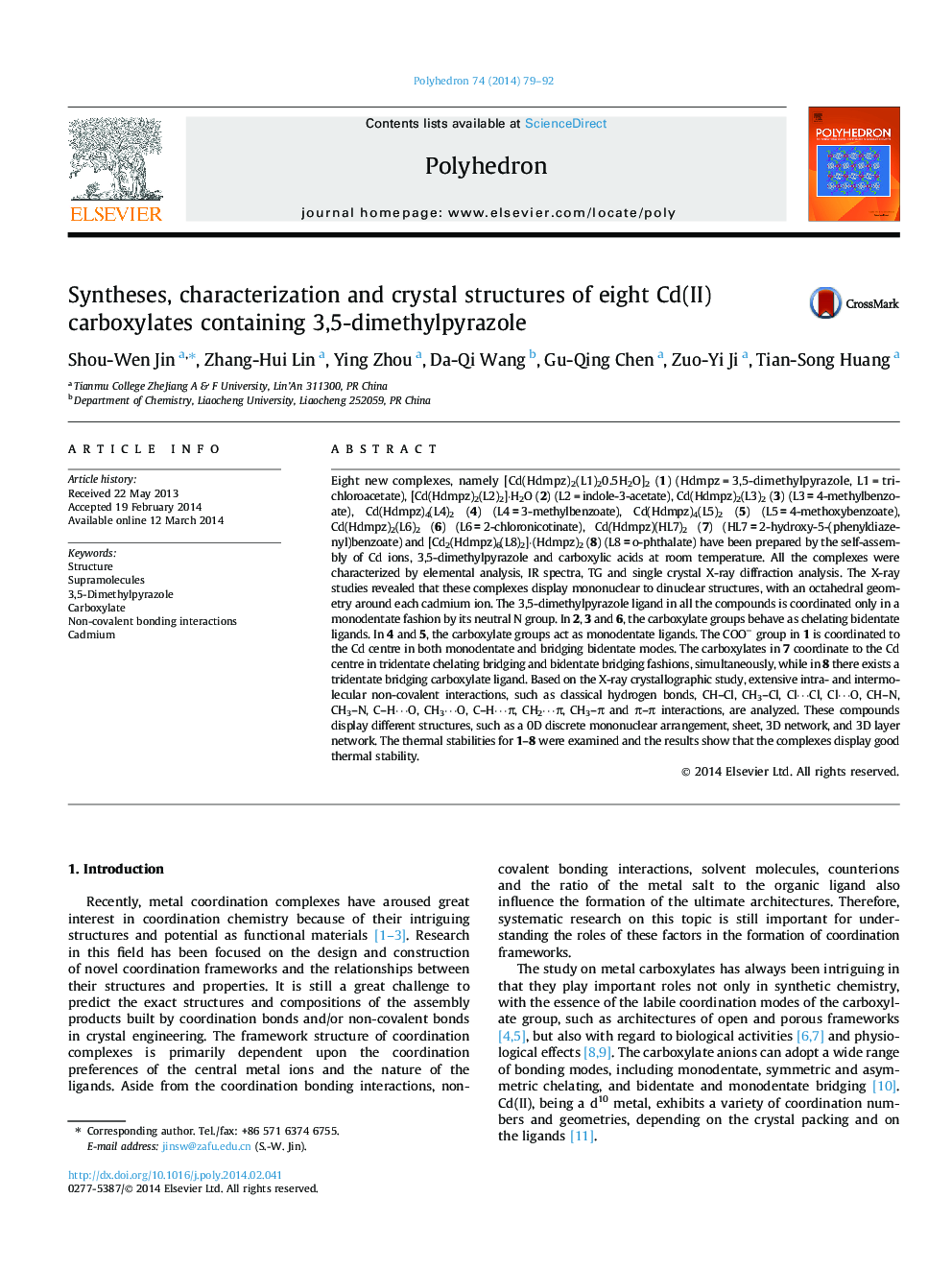| Article ID | Journal | Published Year | Pages | File Type |
|---|---|---|---|---|
| 1336663 | Polyhedron | 2014 | 14 Pages |
Eight new complexes, namely [Cd(Hdmpz)2(L1)20.5H2O]2 (1) (Hdmpz = 3,5-dimethylpyrazole, L1 = trichloroacetate), [Cd(Hdmpz)2(L2)2]·H2O (2) (L2 = indole-3-acetate), Cd(Hdmpz)2(L3)2 (3) (L3 = 4-methylbenzoate), Cd(Hdmpz)4(L4)2 (4) (L4 = 3-methylbenzoate), Cd(Hdmpz)4(L5)2 (5) (L5 = 4-methoxybenzoate), Cd(Hdmpz)2(L6)2 (6) (L6 = 2-chloronicotinate), Cd(Hdmpz)(HL7)2 (7) (HL7 = 2-hydroxy-5-(phenyldiazenyl)benzoate) and [Cd2(Hdmpz)6(L8)2]·(Hdmpz)2 (8) (L8 = o-phthalate) have been prepared by the self-assembly of Cd ions, 3,5-dimethylpyrazole and carboxylic acids at room temperature. All the complexes were characterized by elemental analysis, IR spectra, TG and single crystal X-ray diffraction analysis. The X-ray studies revealed that these complexes display mononuclear to dinuclear structures, with an octahedral geometry around each cadmium ion. The 3,5-dimethylpyrazole ligand in all the compounds is coordinated only in a monodentate fashion by its neutral N group. In 2, 3 and 6, the carboxylate groups behave as chelating bidentate ligands. In 4 and 5, the carboxylate groups act as monodentate ligands. The COO− group in 1 is coordinated to the Cd centre in both monodentate and bridging bidentate modes. The carboxylates in 7 coordinate to the Cd centre in tridentate chelating bridging and bidentate bridging fashions, simultaneously, while in 8 there exists a tridentate bridging carboxylate ligand. Based on the X-ray crystallographic study, extensive intra- and intermolecular non-covalent interactions, such as classical hydrogen bonds, CH–Cl, CH3–Cl, Cl⋯Cl, Cl⋯O, CH–N, CH3–N, C–H⋯O, CH3⋯O, C–H⋯π, CH2⋯π, CH3–π and π–π interactions, are analyzed. These compounds display different structures, such as a 0D discrete mononuclear arrangement, sheet, 3D network, and 3D layer network. The thermal stabilities for 1–8 were examined and the results show that the complexes display good thermal stability.
Graphical abstractEight cadmium complexes with 3,5-dimethylpyrazole and carboxylate ligands were prepared and characterized by EA, IR spectra, TG and single crystal XRD analysis. These complexes display mononuclear to dinuclear structures with an octahedral coordination for the cadmium cation. The extensive non-bonding interactions in 1–8 have been analyzed.Figure optionsDownload full-size imageDownload as PowerPoint slide
